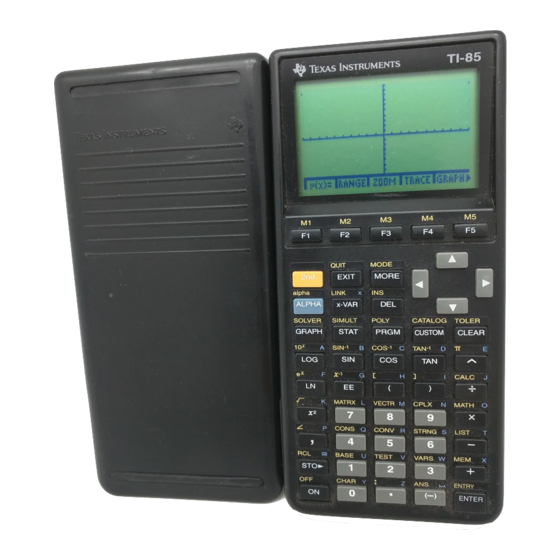Advertisement
Getting started
Texas Instruments TI-85 and TI-86 calculators
Overview: Your graphing calculator or computer is a powerful and flexible tool, which you would
probably be able to use fairly well without reading any instructions. It is important, however, to learn
how to take advantage of some of its not-so-obvious features and how to avoid making errors using it.
Study these instructions and be sure you can work the tune-up exercises at the end.
Topics:
• Basic operations
• Priority of operations in calculations
• The dangers of using improper parentheses
• Exact and approximate decimal values of functions
Basic operations
Press the
key to start the calculator. Press
ON
display contrast and by
when graphs are generated. Press
Normal Sci Eng
Float 012345678901
Radian Degree
RectC PolarC
The words printed in bold type here should be highlighted on the screen. If another item is highlighted or
you want to change a selection, use the cursor keys to move the flashing box to the correct item and press
. <Normal> denotes normal notation for decimals; <Sci> is for scientific notation; and <Eng>
ENTER
for engineering notation. With <Float> selected decimals are printed with twelve digits. Choosing an
integer instead of <Float> causes that many digits be shown after decimal points. (Use the second 0
for ten digits and the second 1 for eleven digits.) <Radian> is for radians and <Degree> for degrees.
<Func> is selected to generate graphs y = f (x) of functions. <Pol> is for polar coordinates, <Par> is
used with parametric equations, and <DifEq> is for differential equations. The other selections will be
explained as needed.
Press
or
EXIT
graph menu. Press
MORE
screen should read
RectGC PolarGC
CoordOn CoordOff
DrawLine DrawDot
SeqG SimulG
with the words in bold highlighted. With <RecGC> and <CoordOn> selected, rectangular coordinates
are used and the coordinates of the cursor are displayed with graphs. Points on graphs are connected
if <DrawLine> is chosen and not with <DrawDot>. Use <SeqG> (sequential graphs) to have two
or more graphs drawn one after the other, and <SimulG> (simultaneous graphs) to have them drawn
at the same time. If <GridOn> were selected, dots would be placed on the screen at the points whose
coordinates correspond to the tickmarks on the axes. The axes would not be shown with <AxesOff>
and labels would be displayed with <LabelOn>.
The key
activates the yellow commands above the keys.
2nd
screen and to remove menus.
with the cursor on a blank line of the home screen clears the screen. In other cases it clears the
CLEAR
line with the cursor or removes a menu.
The key
ALPHA
to decrease it. Change the four AAA batteries as soon as the screen dims
2nd
MODE
to return to the home screen and then
2nd
QUIT
to see the second row of the menu and then press
returns you to the home screen where calculations are made.
2nd
QUIT
puts the calculator in upper-case alpha mode, activating the blue letters and
followed by the up cursor key
2nd
. The screen should show
Func Pol Param DifEq
Dec Bin Oct Hex
RectV CylV SphereV
dxDer1 dxNDer
GridOff GridOn
AxesOn AxesOff
LabelOff LabelOn
EXIT
1
to increase
for the first row of the
GRAPH
for <FORMT>. The
F3
is used to return to a previous
Advertisement
Table of Contents

Summary of Contents for Texas Instruments TI-85
- Page 1 Getting started Texas Instruments TI-85 and TI-86 calculators Overview: Your graphing calculator or computer is a powerful and flexible tool, which you would probably be able to use fairly well without reading any instructions. It is important, however, to learn how to take advantage of some of its not-so-obvious features and how to avoid making errors using it.
- Page 2 Getting started TI-85/86 calculators, 2 other symbols above the keys. Pressing locks the calculator in upper-case alpha mode ALPHA ALPHA and then pressing takes it out of upper-case alpha-lock mode. puts ALPHA ENTER ALPHA it in lower-case alpha mode. Entering a number followed by...
- Page 3 The need to use ∗ Because TI-85 and TI-86 calculators allow words to be used for variables, multiplication signs (∗) must be used between letters that represent numbers to be multiplied. Evaluate AB with A = 5 and B = 2 by first storing the values of A and B.
- Page 4 Atempt to evaluate sin(5)(10) by entering this expression in the calculator. Solution The TI-85 gives the wrong value sin(50) 0.262374853704 because it uses Rule 8 and does the multiplication before evaluating the sine. Use sin 5 ∗ (10) or (sin 5)(10) instead.
- Page 5 Getting started TI-85/86 calculators, 5 Repeat this process for the other two values in the table below. Only the values 27 and x = 8 are exact because only 27 and 8 of the x-values are perfect cubes. y = 5x y = 5x 15.5361625298...
- Page 6 2.00509554966 • Use ENTER ∧ 16 • TI-85 and TI-86 calculators evaluate x for negative x and odd integers n, but do not always give the correct, real value of x with negative x, odd n, and m an integer >...

















Need help?
Do you have a question about the TI-85 and is the answer not in the manual?
Questions and answers